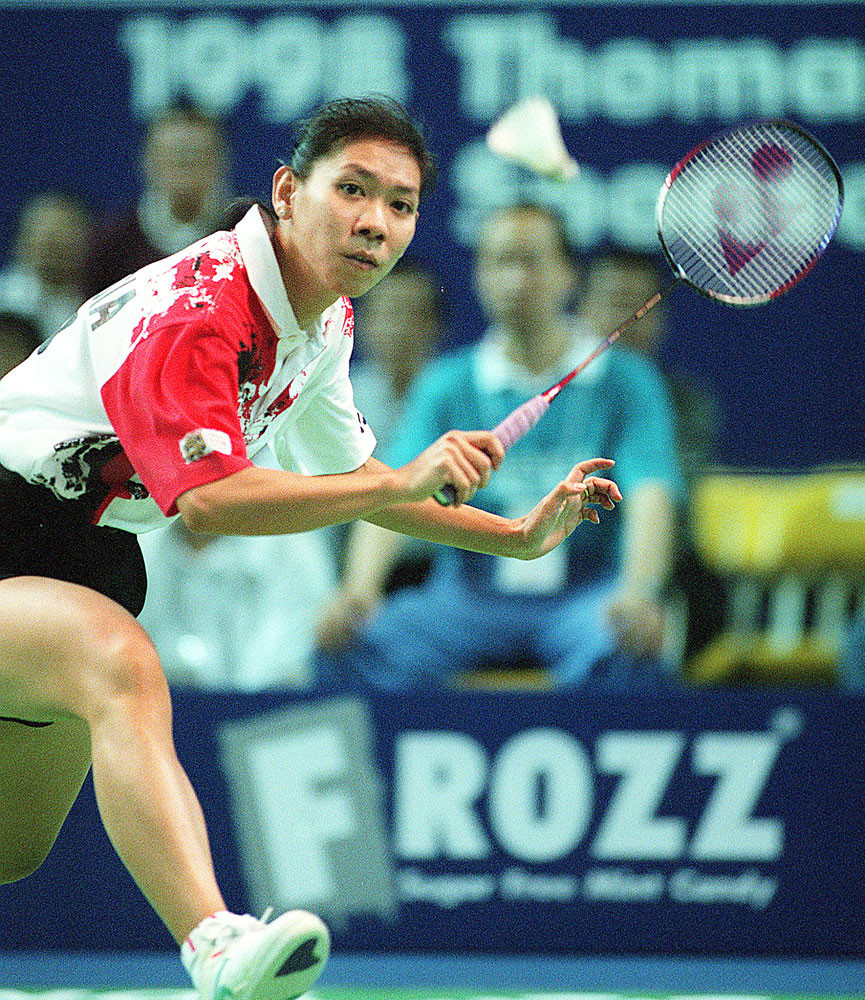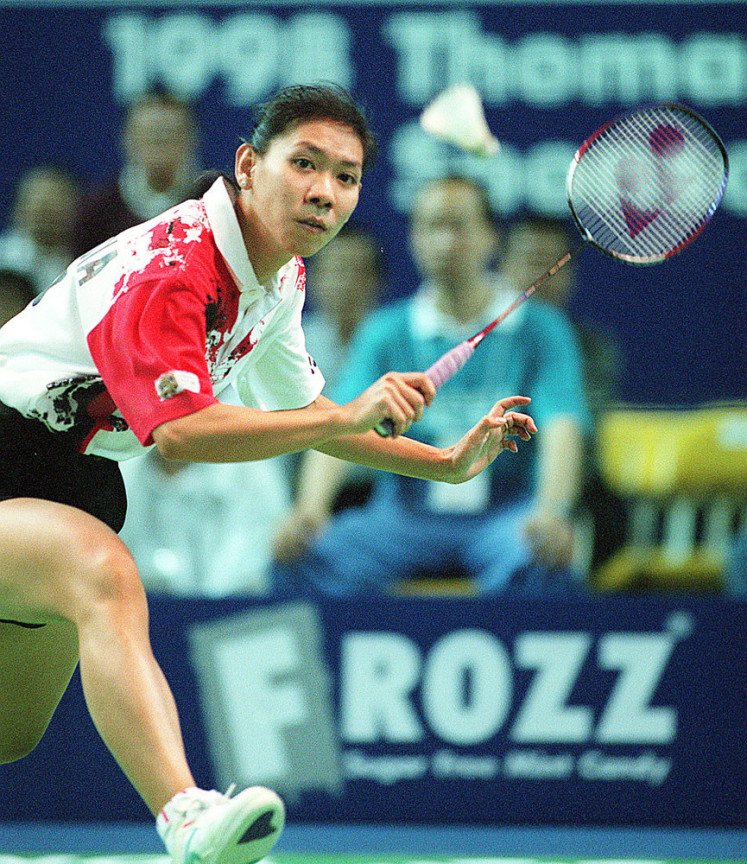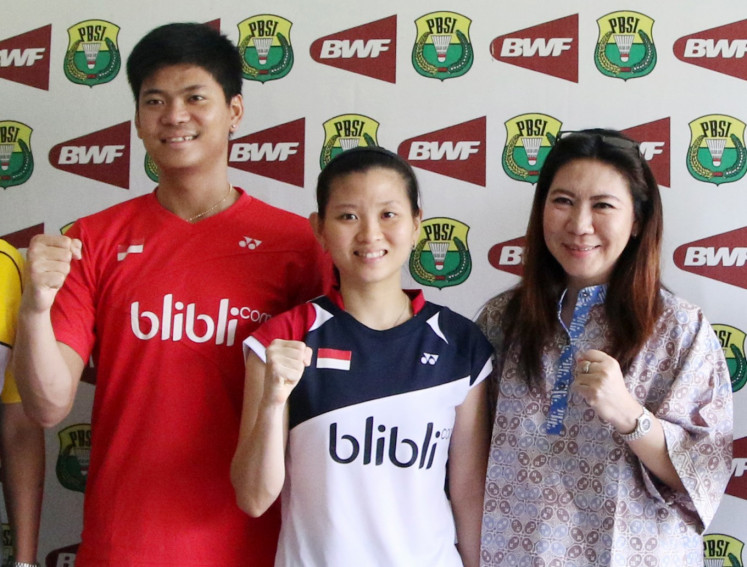Popular Reads
Top Results
Can't find what you're looking for?
View all search resultsPopular Reads
Top Results
Can't find what you're looking for?
View all search resultsIndonesian Icons: Susy Susanti – the first Indonesian Olympic gold medalist
Widely considered to be one of the greatest badminton players of all time, Susy Susanti’s achievements in the world-level competition have made her a living legend.
Change text size
Gift Premium Articles
to Anyone
Contributor/Denpasar
Indonesian Icons is a column providing an in-depth focus on figures, elements and events that have defined the country,
For us Indonesians, Susy Susanti will always be remembered as the first Indonesian Olympic gold medalist, a prestigious honor she won at the Barcelona Summer Olympics in 1992. Clips of Susy standing proud on the podium with tears of joy rolling down her cheeks as the Indonesian national anthem played on, remains one of the country’s most iconic images.
Susy’s significant other, Alan Budikusuma, won the gold medal in the men’s singles following her victory. They were welcomed back in Indonesia as national heroes with parades being held to celebrate them.
Susy and Alan married in 1997. Their first child, Laurencia Averina was born in 1999, followed by Albertus Edward (2000), and Sebastianus Frederick (2003). She was inducted into the sports association’s Hall of Fame in 2004.
Formidable
Susy’s arrival as a force to be reckoned with came three years before her Olympic glory. At the age of 18, she reached the final of the All England Open - the oldest badminton tournament.
Her opponent in that 1989 final was the formidable Li Lingwei of China. Playing in her final year before retirement, Li Lingwei defeated Susy in straight sets 11-8 and 11-4.
It did not take long for Susy to dominate the scene. In 1990, she won the All England by beating Li Lingwei’s successor Huang Hua in two sets. Susy won three more All England titles in 1991 (beating fellow Indonesian Sarwendah Kusumawardhani in the final), 1993 and 1994.
She also won a bronze medal at the 1996 Olympics in Atlanta.
Susy was pivotal in the Indonesian women’s team to win the Uber Cup twice in 1994 and 1996. At the 1996 edition, Susy came back from a set behind to beat her archrival, China’s Ye Zhaoying, despite the latter at the time being a tournament favorite.
By winning the opening match, Susy inspired her teammates – who were the underdogs since the Chinese shuttlers had better rankings overall – to retain the crown.
At 161 cm, Susy was shorter than her rivals. Ye Zhaoying stood tall at 175 cm, while South Korea’s Bang Soo-hyun, another competitor, was 171 cm.
Despite this, Susy was feared due to her suppleness, long-lasting stamina, accuracy and patience. Her intricate footwork, lauded by many, allowed her to cover practically the entire court. Susy’s balletic movement while playing included splits – which became her signature pose - and arching her back to hit overhead forehands when covering her backhand side.
Susy played during the era of the 11 points system in the women’s singles. To win a point, the player needed to hold the serve first. This system allowed Susy to wear down her opponents.
Under the current rally system, players do not have to hold serve to win a point. Whoever gets 21 points first can win a set. In badminton, two sets are needed to win a match in all disciplines.
Talking with The Jakarta Post on July 29, Susy was asked whether she would radically change her style of play if she were active these days.
The answer was no.
“However, I would adapt with the scores. In the past, I was allowed room to develop long rallies. I know that my strength was in the rallies, accuracy and stamina […] so I was not rushed to attack. But with the current system, I would pressure my opponents and get points faster when the chances were there,” she said.
For Susy, winning matches takes more than just athleticism – it requires mental strength and strategy. She likened her approach to playing chess.
“I would prepare Plan A, Plan B and Plan C before meeting an opponent. These three plans can be switched as the match goes on. In split seconds, I needed to be aware of my opponent’s position and anticipate the next shot,” she said.
When asked about her past rivals, Susy cited Ye Zhaoying as her toughest opponent due to the completeness of her game. She praised Ye’s offense that incorporated attacking shots with sharp angles that was also complimented by her good footwork and ability to play long rallies.
“Even with her tall frame, she had good movement. I was often so pressured playing Ye Zhaoying that I had to do a lot of splits,” she said.
As for Bang Soo-hyun, Susy mentioned the South Korean star’s attacking shots were not as sharp as Ye Zhaoying.
“If I could force Bang into playing rubber sets, I would win,” she said.
Little things
Susy Susanti Haditono was born in Tasikmalaya, West Java on February 11, 1971.
Susy’s athleticism and flexibility were not built in one night. She acknowledged that her parents – both badminton enthusiasts – were crucial in developing her body to be a pro player.
Every player's idol: Young badminton players like Praveen Jordan (left) and Debby Susanto (center) look up to Susy Susanti. (PBSI/Courtesy of PBSI)She enrolled in ballet and gymnastics as a child. From there, Susy’s parents trained her suppleness every day when she was young – in order to avoid injuries.
“Before my matches [as a junior], my father would stay up all night to correct my positions during sleep to avoid injuries – because I often accidentally slept on my arms. I was also taught from a young age to wear socks and sweatpants to keep my muscles warm,” she said.
“If you want to be a professional athlete, you have to be professional on-court and off-court,” she said with a smile.
Susy’s life is so well-known that it was adapted into a biopic – Susi Susanti: Love All (2019) – with actress Laura Basuki playing the titular role.
Her journey – including her struggle with racism and citizenship issues due to being of Chinese descent - was depicted in the film. Her decision to remain in Indonesia and represent the country when many of her similarly successful peers decided to move abroad after facing a variety of racially charged challenges and peaking with the May 1998 anti-Chinese riots, was a major part of the film, and showcased her nationalism. Susy and her peers were competing at the 1998 Uber Cup in Hong Kong when the riots happened.
“That movie was 85 percent true. The 15 percent was added to make it more interesting,” she said, adding that the correct spelling of her name was actually “Susy”.
With the film, Susy hoped she could inspire younger generations not to be afraid to dream and be willing to work hard to achieve success.
Current state
Almost three decades after Susy’s Olympic glory, Indonesia was still waiting for another top-ranked player in the women’s singles category.
There was badminton prodigy Mia Audina, who was touted to be her successor in the mid-1990s. In 1999, Mia switched her citizenship and represented the Netherlands after marrying Tylio Lobman.
At the 2008 Beijing Olympics, Maria Kristin Yulianti won the bronze medal despite being unheralded entering the tournament. In 2015, Lindaweni Fanetri won a bronze medal at the BWF World Championships.
Indonesia’s current hope is teenager Putri Kusuma Wardhani, who won the Spain Masters in May 2021.
The Post asked whether she ever got tired of answering questions about who would become her successor. Susy’s answer was diplomatic.
“If such questions are asked, it would be my duty to answer,” she said.
Susy mentioned there had been good players after her era – although noting their lack of consistency. While praising the efforts of the Indonesian Badminton Association (PBSI) to produce more players, Susy noted there were now more badminton competitors from more countries, such as Spain and Thailand.
“But as a country with a strong badminton tradition, we also need to keep up,” she said, adding that she hoped the current badminton athletes competing at the Tokyo Olympics could continue the gold tradition.













